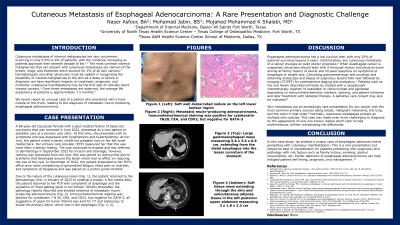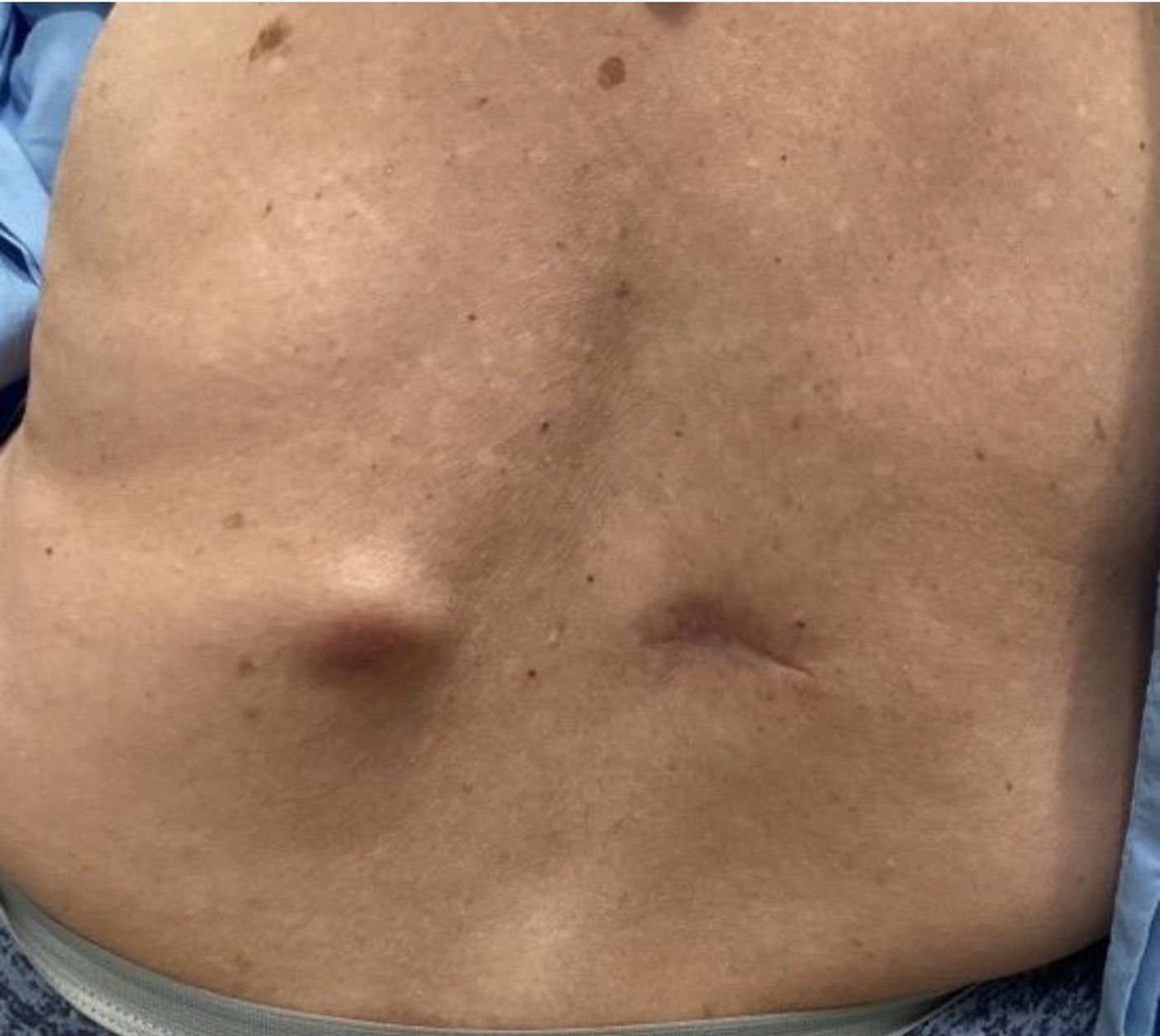Sunday Poster Session
Category: Esophagus
P0479 - Cutaneous Metastasis of Esophageal Adenocarcinoma: A Rare Presentation and Diagnostic Challenge
Sunday, October 22, 2023
3:30 PM - 7:00 PM PT
Location: Exhibit Hall

Has Audio

Naser Asfoor, BA
Texas College of Osteopathic Medicine
Fort Worth, TX
Presenting Author(s)
Naser Asfoor, BA1, Mohamad Jabin, BS2, Mojahed Shalabi, MD3
1Texas College of Osteopathic Medicine, Fort Worth, TX; 2Texas A&M Health Science Center College of Medicine, Dallas, TX; 3Baylor All Saints, Fort Worth, TX
Introduction: Cutaneous metastases of internal malignancies are rare, but they can be the first sign of clinically silent visceral cancers, making it important for physicians to be vigilant in recognizing the possibility of visceral malignancies to the skin. Cutaneous metastases can have significant impacts on treatment, prognosis, and morbidity, with an average life expectancy of approximately 7.5 months.
We herein report an unusual case of a patient who presented with a hard nodule on the trunk, leading to the diagnosis of metastatic mucin-producing esophageal adenocarcinoma.
Case Description/Methods: In this case study, a 68-year-old female presented with a hard nodule on her trunk, leading to the diagnosis of metastatic mucin-producing esophageal adenocarcinoma. The patient had a past medical history of basal cell carcinoma and was initially reassured by her primary care provider that the cyst was likely benign. The cyst continued to expand, and the patient presented with symptoms of dyspepsia and dysphagia, leading to a biopsy and the eventual diagnosis of metastatic adenocarcinoma.
Discussion: Esophageal adenocarcinoma has a low survival rate, and any cutaneous metastasis of cancer divulges an even poorer prognosis. When esophageal cancer is suspected, physicians should start with a thorough history and physical exam, followed by gastroenterology and oncology consultations, endoscopy and biopsy, and imaging for pretreatment staging and evaluation. Patients with cutaneous manifestations of esophageal adenocarcinoma will likely be treated with neoadjuvant chemotherapy and radiation therapy, with a palliative care consult potentially indicated. This case study highlights the importance of considering esophageal adenocarcinoma in patients presenting with suspicious skin pathology, particularly those with risk factors such as family history, smoking, and alcohol consumption, as earlier detection can help mitigate patient well-being, prognosis, and management.

Disclosures:
Naser Asfoor, BA1, Mohamad Jabin, BS2, Mojahed Shalabi, MD3. P0479 - Cutaneous Metastasis of Esophageal Adenocarcinoma: A Rare Presentation and Diagnostic Challenge, ACG 2023 Annual Scientific Meeting Abstracts. Vancouver, BC, Canada: American College of Gastroenterology.
1Texas College of Osteopathic Medicine, Fort Worth, TX; 2Texas A&M Health Science Center College of Medicine, Dallas, TX; 3Baylor All Saints, Fort Worth, TX
Introduction: Cutaneous metastases of internal malignancies are rare, but they can be the first sign of clinically silent visceral cancers, making it important for physicians to be vigilant in recognizing the possibility of visceral malignancies to the skin. Cutaneous metastases can have significant impacts on treatment, prognosis, and morbidity, with an average life expectancy of approximately 7.5 months.
We herein report an unusual case of a patient who presented with a hard nodule on the trunk, leading to the diagnosis of metastatic mucin-producing esophageal adenocarcinoma.
Case Description/Methods: In this case study, a 68-year-old female presented with a hard nodule on her trunk, leading to the diagnosis of metastatic mucin-producing esophageal adenocarcinoma. The patient had a past medical history of basal cell carcinoma and was initially reassured by her primary care provider that the cyst was likely benign. The cyst continued to expand, and the patient presented with symptoms of dyspepsia and dysphagia, leading to a biopsy and the eventual diagnosis of metastatic adenocarcinoma.
Discussion: Esophageal adenocarcinoma has a low survival rate, and any cutaneous metastasis of cancer divulges an even poorer prognosis. When esophageal cancer is suspected, physicians should start with a thorough history and physical exam, followed by gastroenterology and oncology consultations, endoscopy and biopsy, and imaging for pretreatment staging and evaluation. Patients with cutaneous manifestations of esophageal adenocarcinoma will likely be treated with neoadjuvant chemotherapy and radiation therapy, with a palliative care consult potentially indicated. This case study highlights the importance of considering esophageal adenocarcinoma in patients presenting with suspicious skin pathology, particularly those with risk factors such as family history, smoking, and alcohol consumption, as earlier detection can help mitigate patient well-being, prognosis, and management.

Figure: Soft well demarcated nodule on the left lower lumbar region
Disclosures:
Naser Asfoor indicated no relevant financial relationships.
Mohamad Jabin indicated no relevant financial relationships.
Mojahed Shalabi indicated no relevant financial relationships.
Naser Asfoor, BA1, Mohamad Jabin, BS2, Mojahed Shalabi, MD3. P0479 - Cutaneous Metastasis of Esophageal Adenocarcinoma: A Rare Presentation and Diagnostic Challenge, ACG 2023 Annual Scientific Meeting Abstracts. Vancouver, BC, Canada: American College of Gastroenterology.
